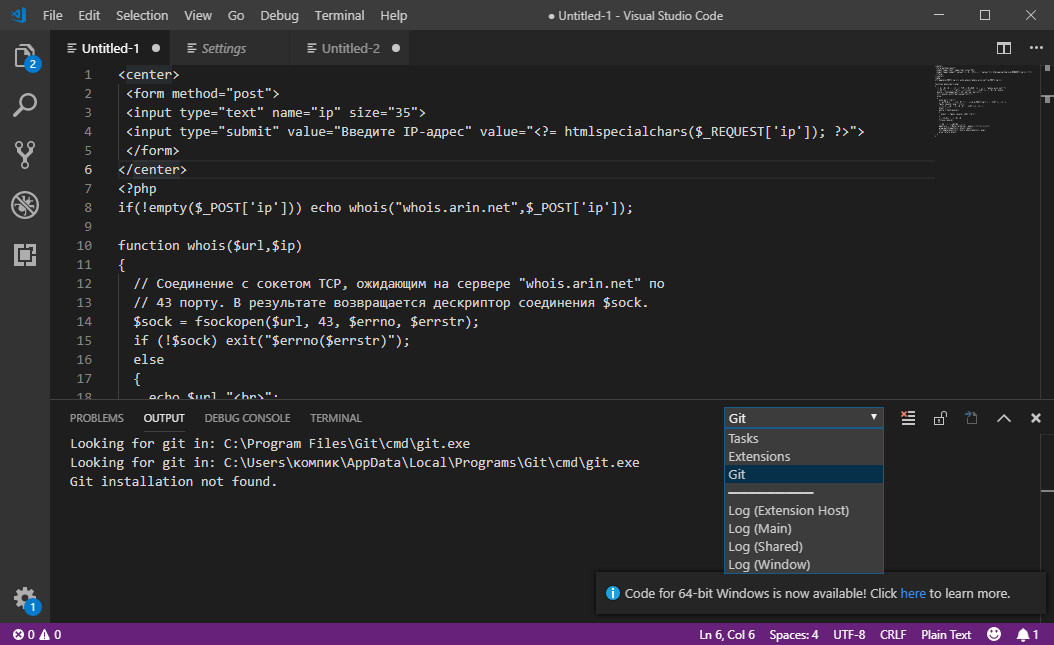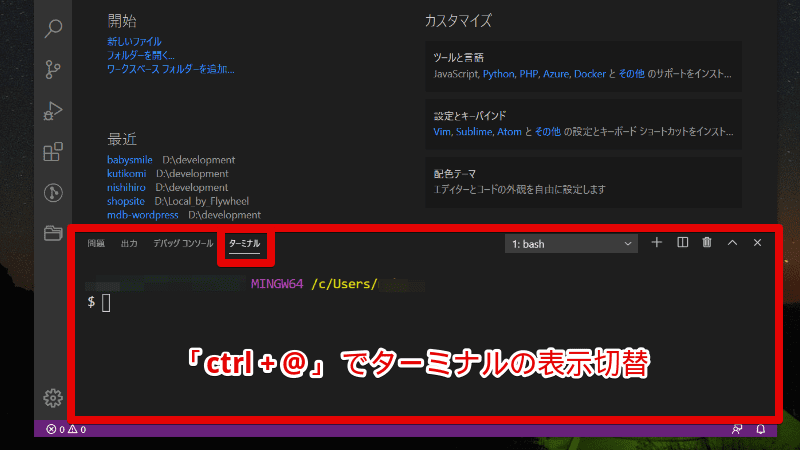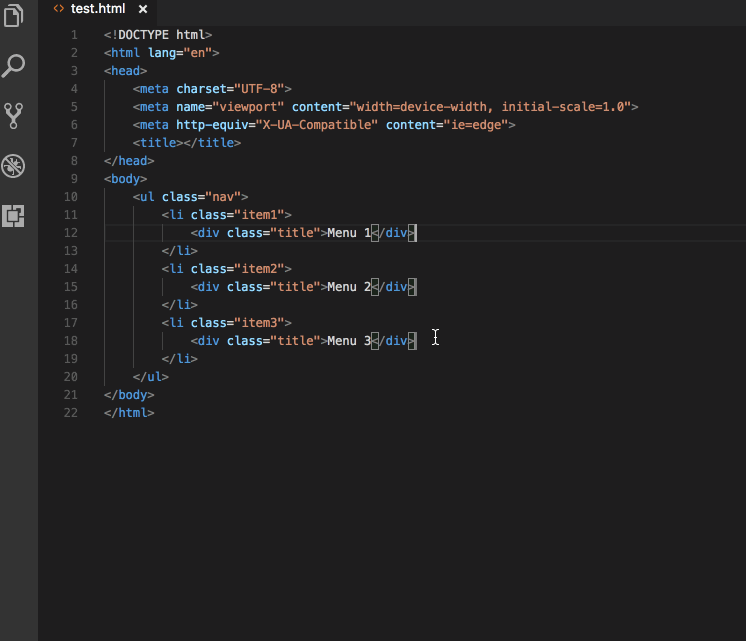- How To Add Emmet In Visual Studio Code
- Help For Emmet In Visual Studio Code Install
- Using Emmet In Visual Studio Code
This video tutorial of Joseph IT shows the way to install emmet plugin or extension in Visual studio code or vscode simply!If you are a visual studio code us. Read on to learn about the Emmet 2.0 changes in Visual Studio Code. New modular approach to Emmet. Previously, the Emmet library was a single monolithic codebase that was used for every Emmet action. The author of Emmet, Sergey Chikuyonok, envisioned a new world for Emmet 2.0 with smaller, re-usable modules. The 'Emmet & HTML' Lesson is part of the full, Visual Studio Code course featured in this preview video. Here's what you'd learn in this lesson: Mike introduces Emmet, a text editor plugin for an abbreviation syntax that generates snippet auto-completions optimizing workflows for HTML, CSS, and JSX. Mike reviews Emmet's HTML abbreviations syntax.
Visual Studio Code supports most of the Emmet Actions including expanding Emmet abbreviations and snippets.
In the July 2017 (v1.15) release of VS Code, we introduced Emmet 2.0, which enabled features like Emmet in the suggestions/auto-completion list, and multi-cursor support. Read more on the why's and how's of this major overhaul in the Emmet 2.0 blog post.
How to expand Emmet abbreviations and snippets
Emmet abbreviation and snippet expansions are enabled by default in html, haml, jade, slim, jsx, xml, xsl, css, scss, sass, less and stylus files. As well as any language that inherits from any of the above like handlebars and php.
When you start typing an Emmet abbreviation, you will see the abbreviation displayed in the suggestion list. If you have the suggestion documentation fly-out open, you will see a preview of the expansion as you type. If you are in a stylesheet file, the expanded abbreviation shows up in the suggestion list sorted among the other CSS suggestions.
Emmet when quickSuggestions are disabled
If you have disabled the editor.quickSuggestionssetting, you won't see suggestions as you type. You can still trigger suggestions manually by pressing kb(editor.action.triggerSuggest) and see the preview.
Disable Emmet in suggestions
If you don't want to see Emmet abbreviations in suggestions at all, then set emmet.showExpandedAbbreviation to never and use the command Emmet: Expand Abbreviation to expand your abbreviations. You can also bind any keyboard shortcut to the command id editor.emmet.action.expandAbbreviation as well.

Using Tab for Emmet expansions
If you want to use the kbstyle(Tab) key for expanding the Emmet abbreviations, add the setting emmet.triggerExpansionOnTab and set it to true. This setting allows using the kbstyle(Tab) key for indentation when text is not an Emmet abbreviation.
Emmet suggestion ordering
Emmet suggestions may not always show up at the top of the suggestion list. This can be either because you have set editor.snippetSuggestions to top or if you are on a stylesheet file, it is sorted among other CSS suggestions. To ensure Emmet suggestions are always on top, you can set emmet.showSuggestionsAsSnippets to true and editor.snippetSuggestions to top.
Emmet abbreviations in other file types
To enable the Emmet abbreviation expansion in file types where it is not available by default, use the emmet.includeLanguages setting. Make sure to use language ids for both sides of the mapping.
For example:
Emmet has no knowledge of these new languages, and so you might feel Emmet suggestions showing up in non html/css context. To avoid this you can set emmet.showExpandedAbbreviation to inMarkupAndStylesheetFilesOnly.
Note: If you used emmet.syntaxProfiles previously to map new file types, from VS Code 1.15 onwards you should use the setting emmet.includeLanguages instead. emmet.syntaxProfiles is meant for customizing the final output only.
Using custom Emmet snippets
Custom Emmet snippets need to be defined in a json file named snippets.json. The emmet.extensionsPath setting should have the path to the directory containing this file.
Below is an example for the contents of this snippets.json file.
Authoring of Custom Snippets in Emmet 2.0 via the snippets.json file differs from the old way of doing the same in a few ways:
| Topic | Old Emmet | Emmet 2.0 |
|---|---|---|
| Snippets vs Abbreviations | Supports both in 2 separate properties called snippets and abbreviations | The 2 have been combined into a single property called snippets. See default html snippets and css snippets |
| CSS snippet names | Can contain : | Do not use : when defining snippet names. It is used to separate property name and value when Emmet tries to fuzzy match the given abbreviation to one of the snippets. |
| CSS snippet values | Can end with ; | Do not add ; at end of snippet value. Emmet will add the trailing ; based on the file type (css/less/scss vs sass/stylus) or the emmet preference set for css.propertyEnd, sass.propertyEnd, stylus.propertyEnd |
| Cursor location | ${cursor} or | can be used | Use only textmate syntax like ${1} for tab stops and cursor locations |
HTML Emmet snippets
HTML custom snippets are applicable to all other markup flavors like haml or jade. When snippet value is an abbreviation and not actual HTML, the appropriate transformations can be applied to get the right output as per the language type.
For example, for an unordered list with a list item, if your snippet value is ul>li, you can use the same snippet in html, haml, jade or slim, but if your snippet value is <ul><li></li></ul>, then it will work only in html files.
If you want a snippet for plain text, then surround the text with the {}.
CSS Emmet snippets
Values for CSS Emmet snippets should be a complete property name and value pair.
CSS custom snippets are applicable to all other stylesheet flavors like scss, less or sass. Therefore, don't include a trailing ; at the end of the snippet value. Emmet will add it as needed based on the whether the language requires it.
Do not use : in the snippet name. : is used to separate property name and value when Emmet tries to fuzzy match the abbreviation to one of the snippets.
Note: After making changes to the snippets.json file, remember to reload VS Code for it to take effect.
Tab stops and cursors in custom snippets
The syntax for tab stops in custom Emmet snippets follows the Textmate snippets syntax.
- Use
${1},${2}for tab stops and${1:placeholder}for tab stops with placeholders. - Previously,
|or${cursor}was used to denote the cursor location in the custom Emmet snippet. This is no longer supported. Use${1}instead.
Emmet configuration
Below are Emmet settings that you can use to customize your Emmet experience in VS Code.
emmet.includeLanguagesUse this setting to add mapping between the language of your choice and one of the Emmet supported languages to enable Emmet in the former using the syntax of the latter.Make sure to use language ids for both sides of the mapping.
For example:
json'emmet.includeLanguages': { 'javascript': 'javascriptreact', 'vue-html': 'html', 'plaintext': 'jade'}emmet.excludeLanguagesIf there is a language where you do not want to see Emmet expansions, add it in this setting which takes an array of language id strings.
emmet.syntaxProfilesSee Emmet Customization of output profile to learn how you can customize the output of your HTML abbreviations.
For example:
json'emmet.syntaxProfiles': { 'html': { 'attr_quotes': 'single' }, 'jsx': { 'self_closing_tag': true }}emmet.variablesCustomize variables used by Emmet snippets.
For example:
json'emmet.variables': { 'lang': 'de', 'charset': 'UTF-16'}emmet.showExpandedAbbreviationControls the Emmet suggestions that show up in the suggestion/completion list.
Setting Value Description neverNever show Emmet abbreviations in the suggestion list for any language. inMarkupAndStylesheetFilesOnlyShow Emmet suggestions only for languages that are purely markup and stylesheet based ('html', 'pug', 'slim', 'haml', 'xml', 'xsl', 'css', 'scss', 'sass', 'less', 'stylus'). alwaysShow Emmet suggestions in all Emmet supported modes as well as the languages that have a mapping in the emmet.includeLanguagessetting.Note: In the
alwaysmode, the new Emmet implementation is not context aware. For example, if you are editing a JavaScript React file, you will get Emmet suggestions not only when writing markup but also while writing JavaScript.emmet.showAbbreviationSuggestionsShows possible emmet abbreviations as suggestions. Its
trueby default.For example, when you type
li, you get suggestions for all emmet snippets starting withlilikelink,link:css,link:faviconetc.This is helpful in learning Emmet snippets that you never knew existed unless you knew the Emmet cheatsheet by heart.Not applicable in stylesheets or when
emmet.showExpandedAbbreviationis set tonever.emmet.extensionsPath
Provide the location of the directory that houses the snippets.json file which in turn has your custom snippets.
emmet.triggerExpansionOnTabSet this to true to enable expanding Emmet abbreviations with
kbstyle(Tab)key. We use this setting to provide the appropriate fallback to provide indentation when there is no abbreviation to expand.emmet.showSuggestionsAsSnippetsIf set to
true, then Emmet suggestions will be grouped along with other snippets allowing you to order them as pereditor.snippetSuggestionssetting. Set this totrueandeditor.snippetSuggestionstotop, to ensure that Emmet suggestions always show up on top among other suggestions.emmet.preferencesYou can use this setting to customize Emmet as documented in Emmet Preferences. The below customizations are currently supported:-
css.propertyEnd-css.valueSeparator-sass.propertyEnd-sass.valueSeparator-stylus.propertyEnd-stylus.valueSeparator-css.unitAliases-css.intUnit-css.floatUnitIf you want support for any of the other preferences as documented in Emmet Preferences, please log a feature request for the same.
How To Add Emmet In Visual Studio Code
Known issues in Emmet 2.0
Below are some of the upstream issues with Emmet 2.0 that we are working on fixing. Any help in these areas is appreciated.
- Use of
@-to get numbering in descending order in repeaters is not supported. Issue: emmetio/html-transform#2 - HTML snippets ending with
+likeselect+andul+from the Emmet cheatsheet are not supported. Issue: emmetio/html-matcher#1
August 7, 2017 Ramya Rao, @ramyanexus
In the July 2017 release of Visual Studio Code (version 1.15), we're shipping a better Emmet experience which has been in preview for the past 2 releases.

Its features include:
- Emmet abbreviation expansions in suggestion/auto-completion lists.
- Multi-cursor support for most Emmet actions.
- Updated support for custom Emmet snippets.
As part of this update, we have re-written all of the Emmet actions using new npm modules from @emmetio.
An important change is that the Tab key is no longer the default way to expand Emmet abbreviations. Instead, Emmet abbreviations will now appear in the suggestion list. They can be selected like any other smart completion and on selection, the abbreviation will be expanded.
Note: To continue to expand Emmet abbreviations and snippets using the Tab key, set emmet.triggerExpansionOnTab to true.
Read on to learn about the Emmet 2.0 changes in Visual Studio Code.
New modular approach to Emmet
Previously, the Emmet library was a single monolithic codebase that was used for every Emmet action. The author of Emmet, Sergey Chikuyonok, envisioned a new world for Emmet 2.0 with smaller, re-usable modules.
There are now separate npm modules from @emmetio for the different parts of the pipeline required to expand an Emmet abbreviation. These include steps such as:
- Parsing an abbreviation
- Resolving snippets and variables
- Rendering output as per syntax
- Applying transformations
There are also separate modules for parsing HTML and CSS documents to aid in implementing the rest of the Emmet features. You can find these modules on npm under emmetio.
This modular approach was taken to allow editor plugins to use the editor specific APIs for better Emmet integration with the editor features. For example, this approach has allowed us to:
- Provide Emmet abbreviation expansions in the suggestion/auto-completion list.
- Provide multi cursor support for most of the Emmet actions.
- Provide more efficient parsing of documents using VS Code specific APIs for Emmet actions that need parsed files.
- Pull the Emmet integration out of the VS Code core and into an extension.
Tab no longer the default Emmet expansion key
There were two issues with using the Tab key as a keyboard shortcut for Emmet expansion:

- Emmet expansions occurred when the user wanted to indent source code using the Tab key.
- Items from the suggestion list were inserted when the user wanted to expand an Emmet abbreviation.
Sergey Chikuyonok realized that having Emmet in the suggestion list would be a more pleasant experience. That it helped us solve the above two issues, was an added bonus.
With Emmet abbreviations now easily accessible via suggestion list, we were able to remove the default association of Tab key with the Emmet: ExpandAbbreviation command. The Tab key is now free to do what it was meant to do: indent.
If you have the editor.quickSuggestionssetting turned off, you will have to press ⌃Space (Windows, Linux Ctrl+Space) to trigger the suggestion/auto-completion list manually.
If you don't want Emmet showing up in the suggestion/auto-completion list, set emmet.showExpandedAbbreviation to never.
You can still bind any keyboard shortcut (other than Tab key) to the editor.emmet.action.expandAbbreviation command or use Emmet: Expand Abbreviation from the Command Palette.
If you prefer the Tab key for expanding your abbreviations, then add the setting emmet.triggerExpansionOnTab to your settings and set it to true. We use this setting to provide the appropriate fallback to provide indentation when there is no abbreviation to expand.
Other changes
There are a few other changes that we have documented in the new Emmet page:
- Use
emmet.includeLanguagesinstead ofemmet.syntaxProfilessetting to enable Emmet in other file types - Changes to how you write custom snippets in Emmet
- Changes to available Emmet settings
- To wrap individual lines in a single selection in separate tags, use the command Emmet: Wrap Individual Lines with Abbreviation instead of Emmet: Wrap with Abbreviation.
- Known issues in Emmet 2.0 that we are working on in August 2017
People who made Emmet 2.0 happen
I want to thank Sergey Chikuyonok for his amazing work on modularizing Emmet and helping us bring these improvements to VS Code.
Thanks also goes to everyone who used the new Emmet in VS Code when it was in preview and provided great feedback through GitHub issues. The discussions in GitHub issues were very helpful in getting to the current user experience.
Help For Emmet In Visual Studio Code Install
Special thanks to Steve Lombardi, Jens Hausdorf, Vladimir Sizikov, Niichie, Thomas Klepzig and many more who used the VS Code Insiders builds to test my bug fixes and feature additions.
Share your thoughts on the new Emmet
Do you miss any features of the old Emmet? Having trouble using the new Emmet? Feel free to create an GitHub issue and we will do our best to help you out.
It is also easier than ever to contribute to Emmet in VS Code as it is now an extension. The emmet folder in the VS Code GitHub repo has all the source code you need to get started.

Using Emmet In Visual Studio Code
Happy Coding!
Ramya Rao, VS Code Team member @ramyanexus
